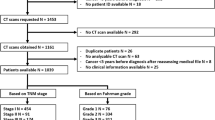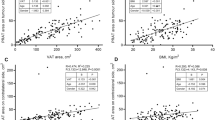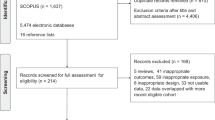Abstract
Objective:
We tested the potential role of abdominal visceral (VAT) and subcutaneous (SAT) adipose tissues, waist circumference (WC) and body mass index (BMI) as prognostic factors in patients with intermediate-risk prostate cancer (clinical stage T1b-2b, and Gleason Score (GS)=7 and prostate-specific antigen PSA level <15 ng ml−1, or GS ⩽6 and PSA between 10 and 20 ng ml−1) treated with ultrasound-based image-guided radiotherapy.
Methods:
VAT, SAT and WC (measured from planning abdominal computed tomography) and BMI were compared with clinical and pathologic factors using univariate analyses. Cox regression analyses were performed to evaluate whether obesity indices significantly predicted biochemical disease free-survival (bDFS).
Results:
Of the 112 eligible patients, 30 (27%) were obese. Median BMI at baseline was 27.5 kg m−2 (range, 19.2–51.5 kg m−2). Greater abdominal adiposity, WC and BMI were significantly associated with younger age at diagnosis and increased prostate volume (P=0.003 and P=0.002, respectively). No significant correlation between obesity measures and T-stage, GS, PSA or percentage of positive cores at biopsy was found. On Cox regression analyses, none of the obesity measures predicted for bDFS. No association was observed between obesity indices and surrogate markers of biochemical failure as PSA nadir (nPSA) or time to nPSA.
Conclusions:
Abdominal adiposity, WC and BMI are associated with younger age at diagnosis and greater prostate volume but not with an increased risk of biochemical failure in patients with intermediate-risk prostate cancer.
This is a preview of subscription content, access via your institution
Access options
Subscribe to this journal
Receive 12 print issues and online access
$259.00 per year
only $21.58 per issue
Buy this article
- Purchase on Springer Link
- Instant access to full article PDF
Prices may be subject to local taxes which are calculated during checkout

Similar content being viewed by others
References
Amling CL, Riffenburgh RH, Sun L, Moul JW, Lance RS, Kusuda L et al. Pathologic variables and recurrence rates as related to obesity and race in men with prostate cancer undergoing radical prostatectomy. J Clin Oncol 2004; 22: 439–445.
Kane CJ, Bassett WW, Sadetsky N, Silva S, Wallace K, Pasta DJ et al. Obesity and prostate cancer clinical risk factors at presentation: data from CaPSURE. J Urol 2005; 173: 732–736.
Freedland SJ, Aronson WJ, Kane CJ, Presti Jr JC, Amling CL, Elashoff D et al. Impact of obesity on biochemical control after radical prostatectomy for clinically localized prostate cancer: a report by the Shared Equal Access Regional Cancer Hospital database study group. J Clin Oncol 2004; 22: 446–453.
Freedland SJ, Grubb KA, Yiu SK, Humphreys EB, Nielsen ME, Mangold LA et al. Obesity and risk of biochemical progression following radical prostatectomy at a tertiary care referral center. J Urol 2005; 174: 919–922.
Strom SS, Wang X, Pettaway CA, Logothetis CJ, Yamamura Y, Do KA et al. Obesity, weight gain, and risk of biochemical failure among prostate cancer patients following prostatectomy. Clin Cancer Res 2005; 11: 6889–6894.
Efstathiou JA, Chen MH, Renshaw AA, Loffredo MJ, D′Amico AV . Influence of body mass index on prostate-specific antigen failure after androgen suppression and radiation therapy for localized prostate cancer. Cancer 2007; 109: 1493–1498.
Palma D, Pickles T, Tyldesley S . Obesity as a predictor of biochemical recurrence and survival after radiation therapy for prostate cancer. BJU Int 2007; 100: 315–319.
Strom SS, Kamat AM, Gruschkus SK, Gu Y, Wen S, Cheung MR et al. Influence of obesity on biochemical and clinical failure after external-beam radiotherapy for localized prostate cancer. Cancer 2006; 107: 631–639.
Stroup SP, Cullen J, Auge BK, L′Esperance JO, Kang SK . Effect of obesity on prostate-specific antigen recurrence after radiation therapy for localized prostate cancer as measured by the 2006 Radiation Therapy Oncology Group-American Society for Therapeutic Radiation and Oncology (RTOG-ASTRO) Phoenix consensus definition. Cancer 2007; 110: 1003–1009.
Loeb S, Yu X, Nadler RB, Roehl KA, Han M, Hawkins SA et al. Does body mass index affect preoperative prostate specific antigen velocity or pathological outcomes after radical prostatectomy? J Urol 2007; 177: 102–106; discussion 106.
Mallah KN, DiBlasio CJ, Rhee AC, Scardino PT, Kattan MW . Body mass index is weakly associated with, and not a helpful predictor of, disease progression in men with clinically localized prostate carcinoma treated with radical prostatectomy. Cancer 2005; 103: 2030–2034.
Efstathiou JA, Skowronski RY, Coen JJ, Grocela JA, Hirsch AE, Zietman AL . Body mass index and prostate-specific antigen failure following brachytherapy for localized prostate cancer. Int J Radiat Oncol Biol Phys 2008; 71: 1302–1308.
Merrick GS, Butler WM, Wallner KE, Galbreath RW, Allen Z, Lief JH et al. Influence of body mass index on biochemical outcome after permanent prostate brachytherapy. Urology 2005; 65: 95–100.
Merrick GS, Galbreath RW, Butler WM, Wallner KE, Allen ZA, Adamovich E . Obesity is not predictive of overall survival following permanent prostate brachytherapy. Am J Clin Oncol 2007; 30: 588–596.
Soete G, Verellen D, Storme G . Image guided radiotherapy for prostate cancer. Bull Cancer 2008; 95: 374–380.
von Hafe P, Pina F, Perez A, Tavares M, Barros H . Visceral fat accumulation as a risk factor for prostate cancer. Obes Res 2004; 12: 1930–1935.
Folsom AR, Kaye SA, Prineas RJ, Potter JD, Gapstur SM, Wallace RB . Increased incidence of carcinoma of the breast associated with abdominal adiposity in postmenopausal women. Am J Epidemiol 1990; 131: 794–803.
Moon HG, Ju YT, Jeong CY, Jung EJ, Lee YJ, Hong SC et al. Visceral obesity may affect oncologic outcome in patients with colorectal cancer. Ann Surg Oncol 2008; 15: 1918–1922.
Oh TH, Byeon JS, Myung SJ, Yang SK, Choi KS, Chung JW et al. Visceral obesity as a risk factor for colorectal neoplasm. J Gastroenterol Hepatol 2008; 23: 411–417.
Schapira DV, Kumar NB, Lyman GH, Cavanagh D, Roberts WS, LaPolla J . Upper-body fat distribution and endometrial cancer risk. JAMA 1991; 266: 1808–1811.
Chandra A, Dong L, Huang E, Kuban DA, O′Neill L, Rosen I et al. Experience of ultrasound-based daily prostate localization. Int J Radiat Oncol Biol Phys 2003; 56: 436–447.
Roach III M, Hanks G, Thames Jr H, Schellhammer P, Shipley WU, Sokol GH et al. Defining biochemical failure following radiotherapy with or without hormonal therapy in men with clinically localized prostate cancer: recommendations of the RTOG-ASTRO Phoenix Consensus conference. Int J Radiat Oncol Biol Phys 2006; 65: 965–974.
Ray ME, Thames HD, Levy LB, Horwitz EM, Kupelian PA, Martinez AA et al. PSA nadir predicts biochemical and distant failures after external beam radiotherapy for prostate cancer: a multi-institutional analysis. Int J Radiat Oncol Biol Phys 2006; 64: 1140–1150.
Kuk JL, Lee S, Heymsfield SB, Ross R . Waist circumference and abdominal adipose tissue distribution: influence of age and sex. Am J Clin Nutr 2005; 81: 1330–1334.
Schoen RE, Thaete FL, Sankey SS, Weissfeld JL, Kuller LH . Sagittal diameter in comparison with single slice CT as a predictor of total visceral adipose tissue volume. Int J Obes Relat Metab Disord 1998; 22: 338–342.
Baumgartner RN, Heymsfield SB, Roche AF, Bernardino M . Abdominal composition quantified by computed tomography. Am J Clin Nutr 1988; 48: 936–945.
Borkan GA, Gerzof SG, Robbins AH, Hults DE, Silbert CK, Silbert JE . Assessment of abdominal fat content by computed tomography. Am J Clin Nutr 1982; 36: 172–177.
Bittner N, Merrick GS, Stewart R, Andreini H, Taubenslag W, Curtis R et al. Obesity does not correlate with adverse pathologic findings on transperineal template-guided mapping biopsy of the prostate. Urol Oncol 2009 (in press).
Millender LE, Aubin M, Pouliot J, Shinohara K, Roach III M . Daily electronic portal imaging for morbidly obese men undergoing radiotherapy for localized prostate cancer. Int J Radiat Oncol Biol Phys 2004; 59: 6–10.
Wong JR, Gao Z, Merrick S, Wilson P, Uematsu M, Woo K et al. Potential for higher treatment failure in obese patients: correlation of elevated body mass index and increased daily prostate deviations from the radiation beam isocenters in an analysis of 1465 computed tomographic images. Int J Radiat Oncol Biol Phys 2009; 75: 49–55.
Serago CF, Chungbin SJ, Buskirk SJ, Ezzell GA, Collie AC, Vora SA . Initial experience with ultrasound localization for positioning prostate cancer patients for external beam radiotherapy. Int J Radiat Oncol Biol Phys 2002; 53: 1130–1138.
Scarbrough TJ, Golden NM, Ting JY, Fuller CD, Wong A, Kupelian PA et al. Comparison of ultrasound and implanted seed marker prostate localization methods: implications for image-guided radiotherapy. Int J Radiat Oncol Biol Phys 2006; 65: 378–387.
Little DJ, Dong L, Levy LB, Chandra A, Kuban DA . Use of portal images and BAT ultrasonography to measure setup error and organ motion for prostate IMRT: implications for treatment margins. Int J Radiat Oncol Biol Phys 2003; 56: 1218–1224.
Freedland SJ, Banez LL, Sun LL, Fitzsimons NJ, Moul JW . Obese men have higher-grade and larger tumors: an analysis of the duke prostate center database. Prostate Cancer Prostatic Dis 2009; 12: 259–263.
Hammarsten J, Hogstedt B . Hyperinsulinaemia as a risk factor for developing benign prostatic hyperplasia. Eur Urol 2001; 39: 151–158.
Maurovich-Horvat P, Massaro J, Fox CS, Moselewski F, O'Donnell CJ, Hoffmann U . Comparison of anthropometric, area- and volume-based assessment of abdominal subcutaneous and visceral adipose tissue volumes using multi-detector computed tomography. Int J Obes (Lond) 2007; 31: 500–506.
Acknowledgements
Dr Thomas Zilli was supported in part by a Fellowship grant from Sanofi-Aventis.
Author information
Authors and Affiliations
Corresponding author
Ethics declarations
Competing interests
The authors declare no conflict of interest.
Rights and permissions
About this article
Cite this article
Zilli, T., Nguyen, T., Bahary, JP. et al. Prognostic impact of abdominal adiposity, waist circumference and body mass index in patients with intermediate-risk prostate cancer treated with radiotherapy. Int J Obes 35, 1421–1426 (2011). https://doi.org/10.1038/ijo.2010.279
Received:
Revised:
Accepted:
Published:
Issue Date:
DOI: https://doi.org/10.1038/ijo.2010.279
Keywords
This article is cited by
-
Performance of prostate cancer recurrence nomograms by obesity status: a retrospective analysis of a radical prostatectomy cohort
BMC Cancer (2018)
-
Visceral adipose tissue measured by computed tomography and high-grade prostate cancer after radical prostatectomy
International Journal of Obesity (2015)
-
Clinical management of obese patients with cancer
Nature Reviews Clinical Oncology (2013)



